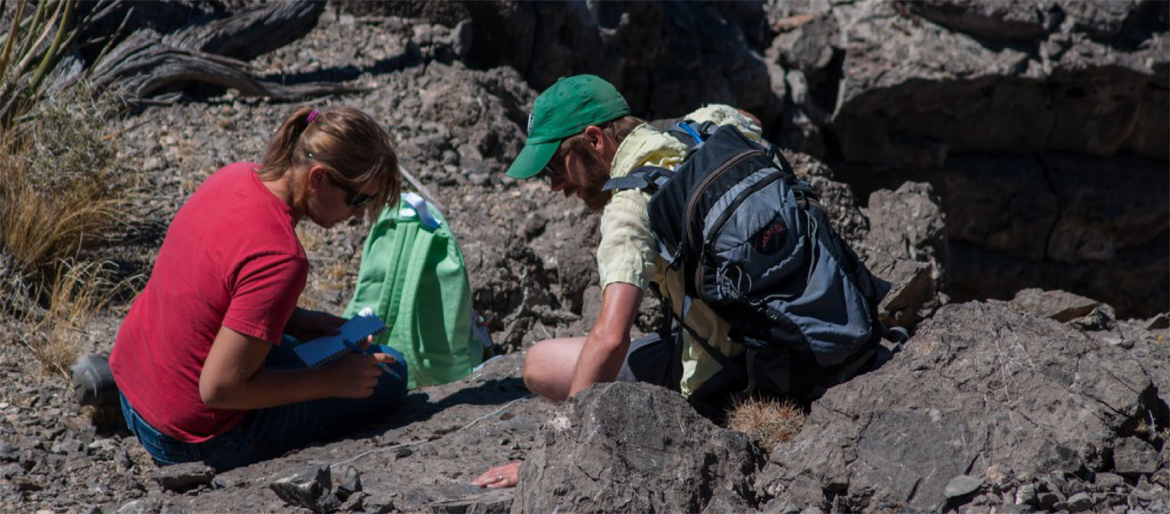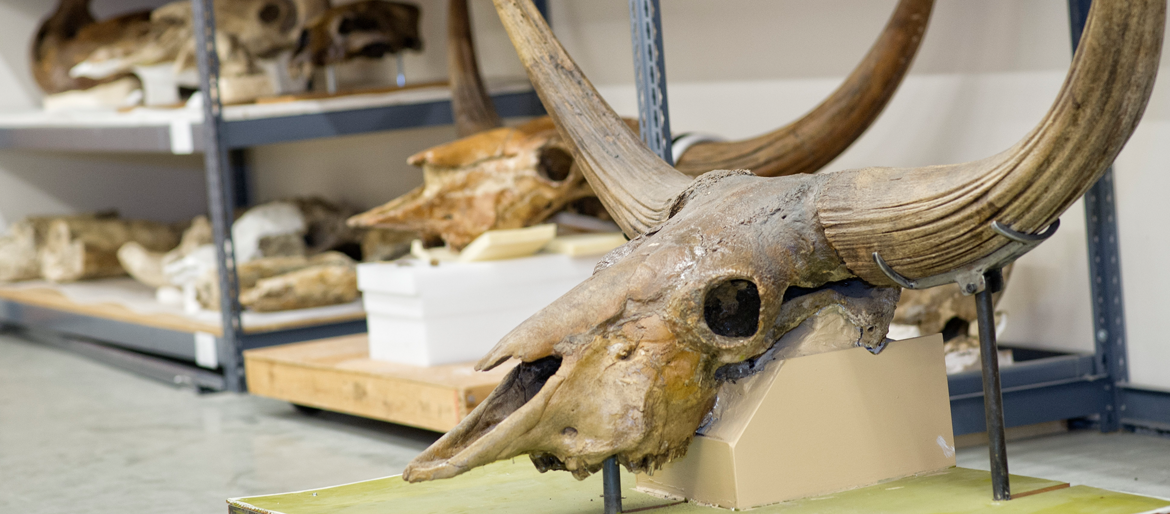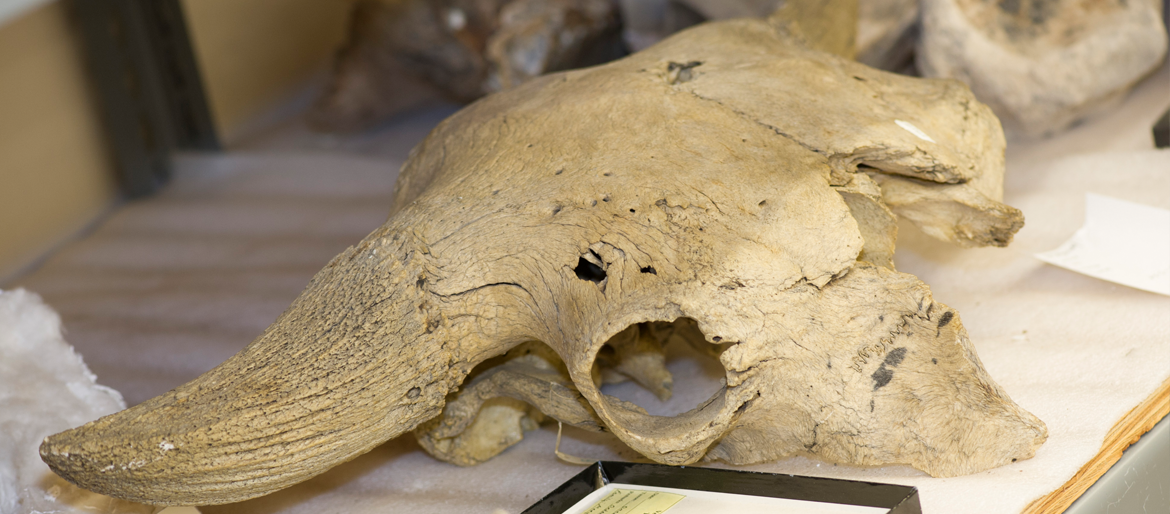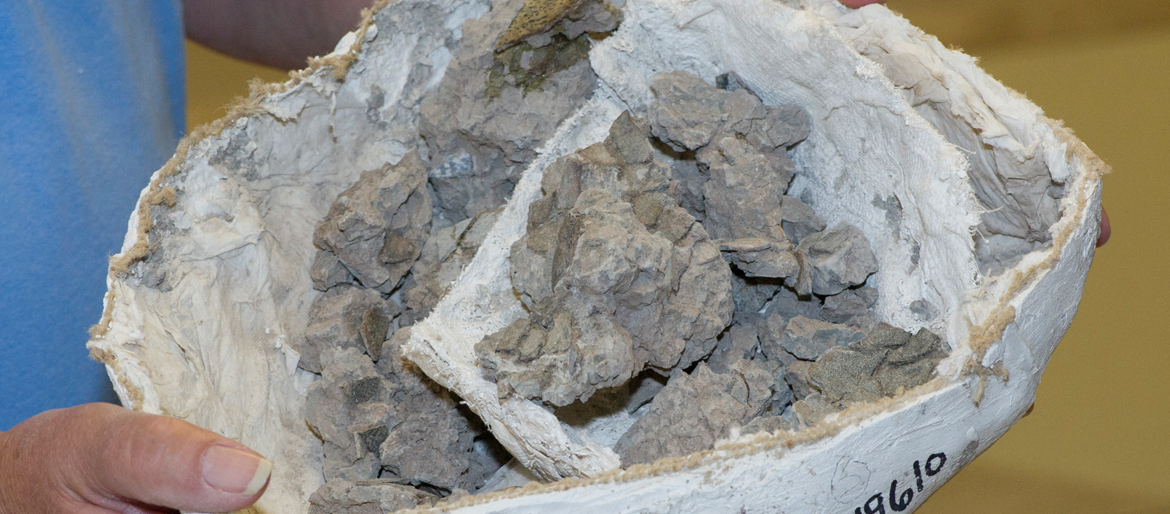Earth Science Division
The Earth Science Division explores and documents the evolution of the physical and biological components of the Earth, and facilitates the understanding and protection of our planet and its record of the past. The specimens we collect and conserve document the occurrence of individual organisms in space and time. Taken together they form a vast (and growing) permanent record, which scientists can examine again and again, applying new analytical techniques and testing new hypotheses.
It consists of 4 main collections and 2 smaller collections. The Vertebrate Paleontology collection includes over 100,000 specimens from Idaho and surrounding states. A major portion of the collections are specimens from federally managed lands that are held in the John A. White Paleontology Repository (JAW). The Paleobotany collection includes over 1400 fossil specimens spanning the time period from the Precambrian Period to the Pleistocene Epoch. The Invertebrate Paleontology collection includes 1200 cataloged specimens from the state of Idaho and the Intermountain West. The Marie Hopkins Comparative Osteology collection includes 2500 bird, mammal, reptile, amphibian, and fish skeletal specimens. The Division also has a substantial geology collection and a teaching/cast collection.
Earth Science Collections
Vertebrate Paleontology
Vertebrate Paleontology is the study of fossil fishes, sharks, amphibians, reptiles, birds, and mammals — animals with internal skeletons including a backbone composed of a series of vertebrae. The IMNH collection holds over 100,000 cataloged specimens of fossil vertebrates, ranging in size from the tiny teeth of bats, shrews, and rodents, to mammoths. Our collections are primarily from Idaho and the Intermountain West. They include representatives of every class of fossil vertebrates, but fossil mammals from the Cenozoic (the last 65 million years) form the bulk of the collections.
The Vertebrate Paleontology section explores, excavates records, prepares, conserves, and researches the fossil resources in the collection at IMNH. In addition to working with private, university, and municipal agencies, IMNH is an official repository for specimens collected from State, Bureau of Reclamation (BOR), Bureau of Land Management (BLM), National Forest (NFSL), and Department of Energy (DOE) lands throughout Idaho.
Invertebrate Paleonotology
Invertebrate Paleontology is the study of fossil invertebrates (animals without backbones). Most groups of invertebrates and geologic ages are represented in the IMNH collection including sponges, corals, trilobites, insects, crustaceans, clams, snails, sea urchins, and sea lilies. The holdings contain 1200 catalogued specimens from the state of Idaho and the Intermountain West. We also have collections of trace fossils, including the tracks, trails and burrows of ancient organisms. Invertebrate fossils are the primary evidence for discovering the rich history of life on Earth and provide important clues to understanding the world's geology. The vast majority of animal species that ever lived are now extinct, and these forms can only be studied as fossils. Their study provides a unique window into the past and allows us to determine how life has responded to climate change throughout time.
Geology
Rocks and the minerals are the building blocks of the earth. Modern technology and our society as a whole depend upon rocks and minerals as raw materials. In fact, rocks and minerals have supported the development of societies and civilizations throughout human history. The scientific study of rocks and minerals is crucial to understanding the earth’s dynamic geologic processes, and illuminates new and better ways to both utilize and conserve our natural resources. Gemstones have been prized since antiquity for adornment and as symbols of status and wealth. Meteorites are some of the oldest pieces of our solar system and are keys to unraveling its origin. Our lapidary collection of polished stones and faceted gems covers both natural and synthetic materials. Specimens have been collected from around the world and with some dating back to the 1930’s, the collections are historical as well as scientific. Private collections, most notably Fujii, Thiel, and Clark Collections, donated to the museum have greatly enhanced the collection.
Marie Hopkins Comparative Osteology Collection
The Comparative Osteology Collection is a teaching and interpretive resource, containing over 2500 bird, mammal, reptile, amphibian, and fish skeletal specimens. Specimens range from a single element to the entire skeleton. The collection is used for teaching comparative osteology, archaeology, and zoology classes at IMNH and ISU. It is also a resource for paleontologists and archaeologists and is used for wildlife forensics by several wildlife agencies.
Most specimens in the collection are from this region (Idaho and the Intermountain West) but as time and opportunity arise, specimens from other regions as well as zoo specimens (elephant, camel, etc.) have been incorporated into the collection. The collection also holds some pathological conditions and genetic anomalies which are of use to researchers studying the effects of nutrition, disease, and genetics on ancient and modern populations.
Paleobotany
Paleobotany is the scientific study of ancient plants. Paleobotanists learn what plants were like long ago from fossils found in sedimentary rocks. These fossils can be impressions or compressions of the plants left on the rock’s surface, or “petrified” objects, such as wood, which preserve the original plant material in rocklike form. Still, other specimens are found in calcified lumps called coal balls, so named because they are usually found in or near coal deposits. The Paleobotany collection contains over 1400 specimens mainly from Idaho.
Identification Requests
The Earth Science Division welcomes object identification requests from the general public. If you have a question about an object in your care, feel free to contact Dr. Tapanila or Dr. Peecook.

Dr. Brandon Peecook
Curator of Vertebrate Paleontology, Associate Professor
Office: Office: Museum Building 113 921 S 8th Ave Stop 8096 Pocatello, ID 83209

Dr. Leif Tapanila
Director/Curator, Earth Sciences/Professor
Office: Museum Building 205B 921 S 8th Ave Stop 8096 Pocatello, ID 83209




